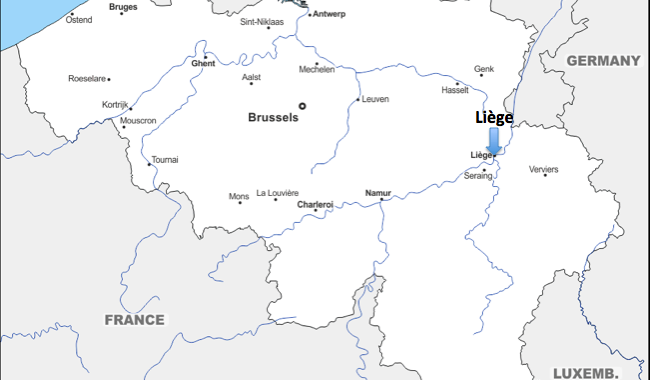
A European Journey #7 – Liège (Belgium)
The people’s Reformation
Welcome to stage 7 of A European Journey.
After Azerbaijan, we will travel a long distance again today, 4000 km to the North West of Europe, and we’ll stop in Liège in Belgium. This city is located along the river Meuse and is surrounded by hills on both sides of the river.
One of the most famous constructions of the city is a bridge over the river with statues of bronze angels called the Pont de Fragnée. From that bridge, we will walk along the Quai de Rome on the left bank of the river for 400 m until a crossroads. That’s where we turn left to a narrow street called Rue des Rivageois. The Rivageois(as there is no translation in English, we can them ‘Riversiders’) were people living in nearby villages along the river.
The name of this street is a testimony of certain events that occurred in the 16thcentury, at the time of the Reformation.
Between the 10th and the 18thcentury, Liège was a Principality with a special status. Since the establishment of Charlemagne’s Empire in the year 800, most of Europe was mainly composed of duchies, principalities or counties which were officially dependent of the Empire. These were usually lead by both state and church, that is prince and bishop.
Liège was a bit different. The Principality of Liège, which covered nearly a fifth of modern-day Belgium, was a prince-bishopric. This means that the prince was actually a bishop of the Roman Catholic Church. Liège had more privileges than most other territories in the Empire. So in practice the principality enjoyed extensive independence for nearly 1000 years. Moreover, Liège was a very rich state, so much so that it was nicknamed The paradise of the priests.
In the 16thcentury the Reformation spread in both France and Germany. As Liège was right in the middle, the principality quickly saw preachers coming from both sides as early as 1520. And many responded to their message, some of who were nobles and state officials.
Sadly the prince-bishop of the time, Erard de la Marck, opposed the Reformation. Seeing how it impacted the principality and being afraid of losing the imperial privileges, he attempted to wipe it out right from the start.
When he saw that his attempts to pass anti-Reformation laws were rejected by the Council, he chose to act on his own. The first known murder of a reformer in Liège was a man whose name has remained unknown. It occurred already in 1528, years before the persecution raged across Europe. In early 1531, peasants from the village of Houssecame singing Psalms in the city, after which they were arrested and executed publicly for this act. As crimes increased, more people came to faith in Jesus Christ.
Then, on the 3rdof July in 1531, the main event of these troubled years took place. It was the Révolte des Rivageois in whichA huge crowd of peasants gathered from several villages at the doors of the city. The reason for their revolt is still unclear to this day. Nevertheless, it is quite sure that the persecution was part of it. Their number and their determination were so great that bishop de la Marck – for once – decided to send some of his officials to negotiate with them.
The promises made by the authorities seemed to calm the peasants. But sadly the benevolence of the authorities was deceptive. Later on they took their revenge. Many were killed, others lost all their possessions, while still others were banished from the principality.
After the death of Erard de la Marck, his successors continued the persecution. Unlike France or Germany, no edict of tolerance was ever promulgated for the Protestants in Liège. Nevertheless, the Reformation kept spreading among the people right up to the 18thcentury. This was only some decades before the Revolution of Liège in 1792, which was itself provoked by the French revolution and the enlightenment.
The persecution led also to a massive exodus of citizens of Liègeto safer lands such as the United Provinces (modern-day Holland), Switzerland and even Scandinavia. Among them was Idelette de Burewho later became Mrs Calvin, the wife of the famous Reformer of Geneva, and also Louis de Geer and Guillaume de Bèche, who later pioneered metal industries in Sweden.
Liège also had its written confession. A man named Thomas Watelet, who had been arrested for preaching the gospel near Spa, wrote it while he was jailed in Liège. He would later be martyred at the stake for his faith.
So Let me finish with an extract of what we can call TheConfession of Liège:
We believe in the Almighty God, Creator of heaven and earth, who made the promise of his own son to Abraham and his posterity, which has been accomplished when, in the fullness of times, His son, by the virtue of the Holy Spirit, took human flesh from the substance of the virgin Mary, reconciling us by his death to God his Father.
See you next week somewhere else in Europe.
Cédric Placentino
Schuman Centre convener for Italian and French Europe
Follow A European Journey here.
Map: https://d-maps.com/index.php?lang=en

This Post Has 0 Comments